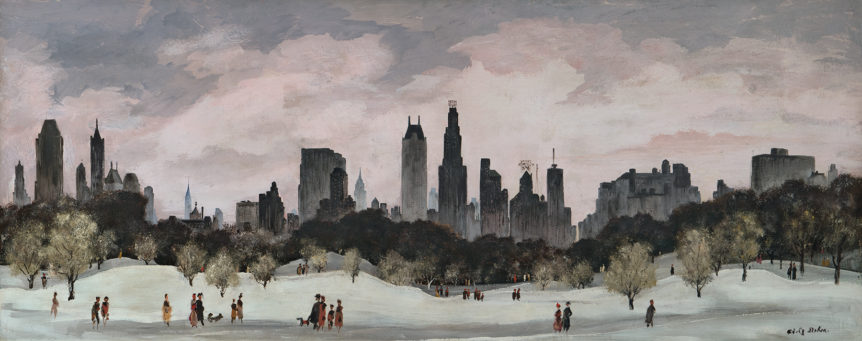In the summer of 1941, the artist Adolf Dehn (1895– 1968) was riding high. Considered a master lithographer, he had been exhibiting extensively in New York City galleries and contributing regularly to magazines such as Vogue, Vanity Fair, and The New Yorker. Nearly every major American museum was acquiring his work. As the cherry on top, Life magazine celebrated Dehn’s art with a fivepage spread in its August 8th issue. But within a few years, as art critics rushed to embrace abstract expressionism, Dehn and many other artists of the social realism school were virtually forgotten. A new exhibition opening this month at the Fairfield University Art Museum in Connecticut aims to restore some luster to Dehn’s name.

Manhattan from Docks by Adolf Dehn, 1947. Estate of Adolf and Virginia Dehn.
The show focuses on his favorite subject: Manhattan, its people and its places. A native of Waterville, Minnesota, Dehn graduated from the Minneapolis Art Institute and won a scholarship to New York City’s Art Students League, which he attended from 1917 to 1918. he left for an extended sojourn in Europe, sketching street scenes and nightlife in the cafés, clubs, and brothels of Paris, Berlin, and Vienna as he honed an eye for social satire. Returning to New York in 1929, he would capture the waning spirit of the Roaring Twenties and darker scenes of the Depression. A staunch political progressive, Dehn’s views could be discerned in works such as his mural, depicting lecherous big shots, for the Greenwich Village jazz boîte Café Society, regarded as the country’s first truly integrated nightclub.

Brooklyn Waterfront by Dehn, 1930. Estate of Adolf and Virginia Dehn.
If in the late 1940s and into the ‘50s the brawny individualism of Jackson Pollock, Willem de Kooning, and other abstract expressionists made Dehn’s work seem quaint, the Fairfield University Art Museum show reminds us of a lighter and optimistic artistic temperament at play in those days and in that city. Dehn’s work from the 1920s through the 1960s—his sketches, drawings, lithographs, and watercolors showing wideangle views of Manhattan from the Brooklyn docks or the Staten Island Ferry and in particular from Central Park— offer a salutary breath of fresh air.

Central Park Winter by Dehn, 1957. Collection of Sarah and Elie Hirschfeld
The exhibiton coincides with the publication of Adolf Dehn: Midcentury Manhattan by Fairfield University art history professor Philip Eliasoph (The Artist Book Foundation, 2017).
Adolf Dehn: Midcentury Manhattan • Fairfield University Art Museum, Fairfield, Connecticut • January 27 to April 7, 2017 • fairfield.edu/museum

